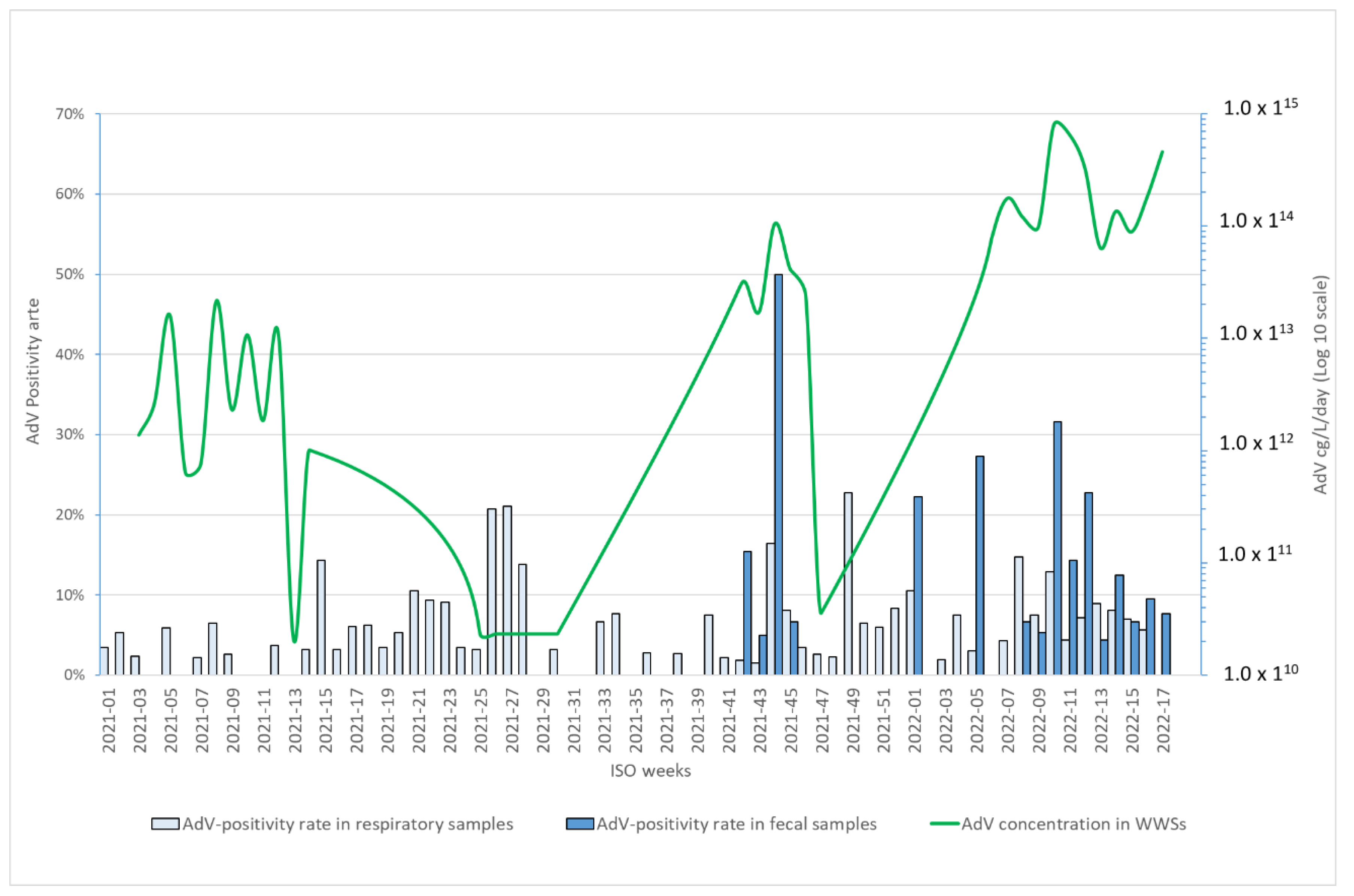Wastewater Surveillance Captured an Increase in Adenovirus Circulation in Milan (Italy) during the First Quarter of 2022
Abstract
1. Introduction
2. Materials and Methods
2.1. AdV Genome Detection, Quantification and Molecular Characterization in Wastewater Samples
2.2. Epidemiological Data
3. Results
4. Discussion
5. Conclusions
Supplementary Materials
Author Contributions
Funding
Data Availability Statement
Acknowledgments
Conflicts of Interest
References
- European Centre for Disease Prevention and Control. ECDC. Epidemiological Update Issued 17 June 2022: Hepatitis of Unknown Aetiology in Children. Available online: https://www.ecdc.europa.eu/en/hepatitis/joint-hepatitis-unknown-origin-children-surveillance-bulletin (accessed on 24 October 2022).
- WHO. Multi-Country–Acute, Severe Hepatitis of Unknown Origin in Children. Available online: https://www.who.int/emergencies/disease-outbreak-news/item/2022-DON376 (accessed on 29 June 2022).
- Samarasekera, U. Mystery outbreak of severe acute hepatitis in children. Lancet Gastroenterol. Hepatol. 2022, 7, 601. [Google Scholar] [CrossRef]
- UK Health Security Agency. Acute Hepatitis of Unknown Aetiology: Technical Briefing 3. Available online: https://assets.publishing.service.gov.uk/government/uploads/system/uploads/attachment_data/file/1077027/acute-hepatitis-technical-briefing_3.pdf (accessed on 29 June 2022).
- The Centers for Disease Control and Prevention (CDC). Clinical Recommendations for Adenovirus Testing and Reporting of Children with Acute Hepatitis of Unknown Etiology. Clinician Outreach and Communication Activity (COCA). Available online: https://emergency.cdc.gov/coca/calls/2022/callinfo_051922.asp?ACSTrackingID=USCDC_1052-DM81645&ACSTrackingLabel=%20Clinical%20Recommendations%20for%20Adenovirus%20Testing%20and%20Reporting%20of%20Children%20with%20Acute%20Hepatitis%20of%20Unknown%20Etiology%20May%2019th%2C%2020&deliveryName=USCDC_1052-DM81645 (accessed on 29 June 2022).
- Brodin, P.; Arditi, M. Severe acute hepatitis in children: Investigate SARS-CoV-2 superantigens. Lancet Gastroenterol. Hepatol. 2022, 7, 594–595. [Google Scholar] [CrossRef]
- Nattino, G.; Castiglioni, S.; Cereda, D.; Della Valle, P.G.; Pellegrinelli, L.; Bertolini, G.; Pariani, E. Association Between SARS-CoV-2 Viral Load in Wastewater and Reported Cases, Hospitalizations, and Vaccinations in Milan, March 2020 to November 2021. JAMA 2022, 327, 1922. [Google Scholar] [CrossRef] [PubMed]
- Lion, T.; Kosulin, K.; Landlinger, C.; Rauch, M.; Preuner, S.; Jugovic, D.; Pötschger, U.; Lawitschka, A.; Peters, C.; Fritsch, G.; et al. Monitoring of adenovirus load in stool by real-time PCR permits early detection of impending invasive infection in patients after allogeneic stem cell transplantation. Leukemia 2010, 24, 706–714. [Google Scholar] [CrossRef] [PubMed]
- La Rosa, G.; Iaconelli, M.; Veneri, C.; Mancini, P.; Bonanno Ferraro, G.; Brandtner, D.; Lucentini, L.; Bonadonna, L.; Rossi, M.; Grigioni, M.; et al. The rapid spread of SARS-CoV-2 Omicron variant in Italy reflected early through wastewater surveillance. Sci. Total Environ. 2022, 837, 155767. [Google Scholar] [CrossRef] [PubMed]
- Castiglioni, S.; Schiarea, S.; Pellegrinelli, L.; Primache, V.; Galli, C.; Bubba, L.; Mancinelli, F.; Marinelli, M.; Cereda, D.; Ammoni, E.; et al. SARS-CoV-2 RNA in urban wastewater samples to monitor the COVID-19 pandemic in Lombardy, Italy (March–June 2020). Sci. Total Environ. 2021, 806, 150816. [Google Scholar] [CrossRef] [PubMed]
- Jothikumar, N.; Cromeans, T.L.; Hill, V.R.; Lu, X.; Sobsey, M.D.; Erdman, D.D. Quantitative real-time PCR assays for detection of human adenoviruses and identification of serotypes 40 and 41. Appl. Environ. Microbiol. 2005, 71, 3131–3136. [Google Scholar] [CrossRef] [PubMed]
- Lu, X.; Erdman, D.D. Molecular typing of human adenoviruses by PCR and sequencing of a partial region of the hexon gene. Arch Virol. 2006, 151, 1587–1602. [Google Scholar] [CrossRef] [PubMed]
- The Lancet Infectious Diseases. Explaining the unexplained hepatitis in children. Lancet Infect. Dis. 2022, 22, 743. [Google Scholar] [CrossRef]
- Marsh, K.; Tayler, R.; Pollock, L.; Roy, K.; Lakha, F.; Ho, A.; Henderson, D.; Divala, T.; Currie, S.; Yirrell, D.; et al. Investigation into cases of hepatitis of unknown aetiology among young children, Scotland, 1 January 2022 to 12 April 2022. Eurosurveillance 2022, 27, 2200318. [Google Scholar] [CrossRef] [PubMed]
- Cooper, S.; Tobar, A.; Konen, O.; Orenstein, N.; Kropach, N.; Landau, Y.; Mozer-Glassberg, Y.; Bar-Lev, M.R.; Shaoul, R.; Shamir, R.; et al. Long COVID-19 Liver Manifestation in Children. J. Pediatr. Gastroenterol. Nutr. 2022; Epub ahead of print. [Google Scholar] [CrossRef] [PubMed]
- Jiang, L.; Tang, K.; Levin, M.; Irfan, O.; Morris, S.K.; Wilson, K.; Klein, J.D.; Bhutta, Z.A. COVID-19 and multisystem inflammatory syndrome in children and adolescents. Lancet Infect. Dis. 2020, 20, e276–e288. [Google Scholar] [CrossRef]

Publisher’s Note: MDPI stays neutral with regard to jurisdictional claims in published maps and institutional affiliations. |
© 2022 by the authors. Licensee MDPI, Basel, Switzerland. This article is an open access article distributed under the terms and conditions of the Creative Commons Attribution (CC BY) license (https://creativecommons.org/licenses/by/4.0/).
Share and Cite
Pellegrinelli, L.; Uceda Renteria, S.C.; Ceriotti, F.; Ammoni, E.; Galli, C.; Seiti, A.; Castiglioni, S.; Cereda, D.; Binda, S.; Pariani, E. Wastewater Surveillance Captured an Increase in Adenovirus Circulation in Milan (Italy) during the First Quarter of 2022. Viruses 2022, 14, 2351. https://doi.org/10.3390/v14112351
Pellegrinelli L, Uceda Renteria SC, Ceriotti F, Ammoni E, Galli C, Seiti A, Castiglioni S, Cereda D, Binda S, Pariani E. Wastewater Surveillance Captured an Increase in Adenovirus Circulation in Milan (Italy) during the First Quarter of 2022. Viruses. 2022; 14(11):2351. https://doi.org/10.3390/v14112351
Chicago/Turabian StylePellegrinelli, Laura, Sara Colonia Uceda Renteria, Ferruccio Ceriotti, Emanuela Ammoni, Cristina Galli, Arlinda Seiti, Sara Castiglioni, Danilo Cereda, Sandro Binda, and Elena Pariani. 2022. "Wastewater Surveillance Captured an Increase in Adenovirus Circulation in Milan (Italy) during the First Quarter of 2022" Viruses 14, no. 11: 2351. https://doi.org/10.3390/v14112351
APA StylePellegrinelli, L., Uceda Renteria, S. C., Ceriotti, F., Ammoni, E., Galli, C., Seiti, A., Castiglioni, S., Cereda, D., Binda, S., & Pariani, E. (2022). Wastewater Surveillance Captured an Increase in Adenovirus Circulation in Milan (Italy) during the First Quarter of 2022. Viruses, 14(11), 2351. https://doi.org/10.3390/v14112351






